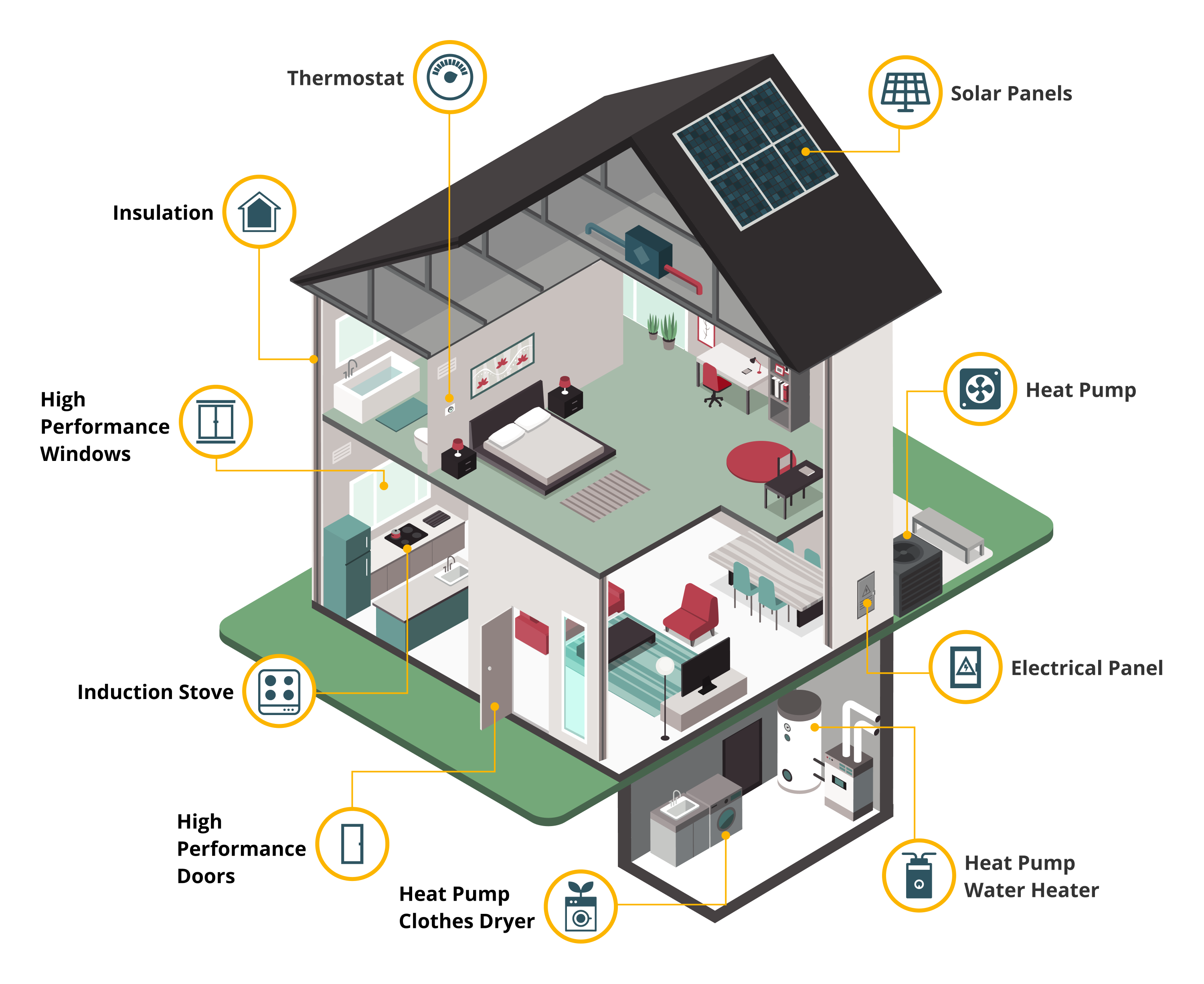Ready to embark on a journey towards achieving a net-zero home? Join us to uncover energy-saving secrets, explore financing options, and draw inspiration from real-life stories.
Here’s what awaits you:
- Achieving Net Zero: Discover how to save on energy bills, combat climate change, and increase your home’s value.
- Steps to Success: Enhance efficiency, transition to electric systems, and harness solar power.
- Cost Breakdown: Delve into a detailed overview of the expenses tied to achieving a net-zero home.
- Financial Support: Learn about HEEHRA rebates, tax credits, and various financing options.
- Real-World Insights: Be inspired by homeowners who have successfully achieved net-zero living.
In this article (Skip to...)
- Principles of net zero
- How much does it cost?
- What are HEEHRA rebates?
- 2023 energy-efficient tax credits
- How to pay for zero-net improvements
- Energy-efficiency in action
How to say goodbye to energy bills for good
Eliminate home energy costs: check.
Slow climate change: check.
Increase your home’s value: check.
The thing about achieving net zero – the point at which your home produces as much energy as it consumes – is that it feels good in so many ways.
How could someone effectively cancel their energy bills forever?
Turns out, this goal is simpler to achieve than you might think. The basic plan is:
- Increase home efficiency
- Replace gas-powered systems with electric ones
- Install solar panels
And thanks to the recently passed Inflation Reduction Act (IRA), zero-energy life is more affordable than ever before.

Principles of net zero
There’s a right way to go about achieving net zero: “Efficient, electric, renewable, in that order,” says Ryan Shanahan, a net-zero homeowner and zero-energy retrofits manager at Birdsmouth, a Portland, Ore. energy-efficient housing company.
Check home improvement loan options and rates. Start hereShanahan knows a thing or two about achieving net-zero homes. He not only helps homeowners cancel out energy usage as a day job, but he and his wife, Megan Milligan, also converted their 1907 home to a modern, zero-energy home. Shanahan and Milligan have been featured on CNBC Make It, the Go Zero Tour, and more.
His best advice: “Start with an energy audit.” A professional audit shows the homeowner the biggest problem areas. “Many people have a gaping hole in their home but don’t know it,” says Shanahan. “They have no insulation in the crawl space and their attic access is effectively a hole to the outside.”
Energy loss fixes could be much cheaper and more effective than, say, replacing an old appliance.
Only after you’ve addressed inefficiencies should you move on to the next step: electrification.
Sam Wigness, content specialist at Solar.com and owner of a solar-powered home, agrees. “Electrification is key; you can’t offset gas. A huge part of going net zero is getting the whole home on electric.”
Plus, burning gas isn’t exactly slowing climate change.
“When it’s time to replace an appliance like a stove or a mechanical system like a furnace, always go electric,” says Shanahan. He even suggests replacing newer gas systems. “Environmentally, that’s the most sustainable move. Plus, you’ll be able to power those systems with solar someday.”
Renewable, or adding a renewable power source to the home, is the last step in Shanahan’s plan.
This comes last because you won’t know how much power you’ll use – or not use – until your electrification and energy-efficient upgrades are in place.
How much does it cost to get to net zero?
We wondered, how much would it cost the average homeowner to “go zero” like Shanahan did?
While Shanahan spent around $48,000 after rebates and tax credits, he says this is less than most will spend. “I did a lot of the work myself,” he says, “plus, I intentionally purchased a rectangle home with the long side facing south.” This orientation made energy conservation and solar energy production easier.
Check home improvement loan options and rates. Start hereSo, what could a homeowner expect? Surprisingly, our estimate came in close to Shanahan’s final cost – but only because of generous government incentives now available. While our before-incentive net-zero home upgrades would cost an eye-popping $80,370, our after-incentive cost penciled out at just $53,380.
Here’s the cost of converting a standard home into a net-zero one (based on assumptions in our methodology), after new, generous rebates and tax credits available in 2023.
| Improvement | After-incentive cost |
| Energy audit | $265 |
| Energy loss fixes | $10,000 |
| Heat pump | $10,500 |
| Heat pump water heater | $1,355 |
| Induction stove | $360 |
| New electrical panel | $1,500 |
| Electrification improvements sub-total | $23,980 |
| Solar panels and installation | $29,400 |
| Grand total to achieve net zero | $53,380 |
Let’s dive into costs, incentives, and the benefits of each improvement.
Professional energy audit - Final cost: $265
| Energy audit | $415 |
| Tax credit | -$150 |
| Final cost | $265 |
While a professional energy audit doesn’t save you energy directly, it’s the most important step in achieving net zero. Skipping an energy audit is like trying to drive to a party with no address or map. An energy auditor will give you a punch list of items to tackle, indicating the biggest issues first.
Incentives: Many utilities offer a free energy audit. If there is a cost, you can claim a tax credit of $150.
Energy loss fixes - Final cost: $10,000
| Address energy loss issues | $10,000 |
This is where cost estimates are tricky.
Completing items in your energy audit action plan could cost $500 in a newer home or $30,000 or more in an older home. A 1950s home might need new windows, doors, insulation, air sealing, and more. A 2015 home may only need some caulk and weather stripping.
For this reason, we added a middle-of-the-road $10,000 allowance to address energy inefficiencies. Just know that your cost could be much less – or much more – depending on your energy audit.
Incentives: $1,600 point-of-sale rebate for insulation, air sealing, and ventilation under the High-Efficiency Electric Homes and Rebates Act (HEEHRA) program plus plentiful rebates from local utilities.
Incentives: Many utilities offer a free energy audit. If there is a cost, you can claim a tax credit of $150.
Check home improvement loan options and rates. Start hereHeat pump - Final cost: $10,500
| Heat pump cost with installation | $20,000 |
| HEEHRA rebate (50% up to $8,000) | -$8,000 |
| Example local incentive | -$1,500 |
| Final cost | $10,500 |

A heat pump is one of the most important parts of creating a net-zero home. While spendy, look for a heat pump that does not require a backup gas furnace. “I would expect to pay at least $20,000,” says Shanahan. Note that this is much higher than the averages you might see online.
According to EnergyStar.gov, you could save over 30,000 pounds of greenhouse gas emissions during the life of the system.
Incentives: 50% of equipment and installation costs up to $8,000 at the time of purchase for households eligible for HEEHRA rebates. Those over HEEHRA income limits can receive a tax credit of up to 30% of the cost of an Energy Star-rated heat pump and installation, up to $2,000. Your local utility may offer additional incentives, such as the Seattle area’s Puget Sound Energy rebate of $1,500 for customers who replace an electric forced-air system with a high-efficiency heat pump.
Heat pump water heater - Final cost: $1,355
| Heat pump water heater cost | $3,755 |
| HEEHRA rebate | -$1,750 |
| Example local incentive | -$650 |
| Final cost | $1,355 |

A heat pump water heater uses similar technology as a heat pump for space heating and cooling. This still little-known device is three to four times as efficient as an electric or gas water heater, saving a family of four $550 per year, says EnergyStar.gov.
Incentives: A $1,750 rebate up to 50% of the cost of equipment and installation is available via HEEHRA rebates. In addition, EnergyStar.gov estimates that local utilities and municipalities offer additional heat pump water incentives to the tune of $300-$1,000, which we averaged as an example local incentive.
Induction stove - Final cost: $360
| Induction stove cost | $1,200 |
| HEEHRA rebate | -$840 |
| Final cost | $360 |

This technological wonder uses a magnetic field instead of an open flame or direct heat for cooking. It tones down the ambient heat released from a gas or standard electric stovetop.
Another benefit: cleaner indoor air. Recent studies have shown that cooking with gas indoors can lead to child asthma, plus general indoor and outdoor air pollution.
Incentives: Qualifying households get an $840 discount at the register through a HEEHRA rebate.
Electrical panel replacement - Final cost: $1,500
| 200 amp electrical panel replacement with labor | $3,000 |
| HEEHRA rebate (50%) | -$1,500 |
| Final cost | $1,500 |

The “catch” when it comes to replacing gas systems with electric ones is that you’ll likely have to upgrade your home’s electrical system.
That’s why we added this cost into the net-zero equation. You may not need it, but you should go into the process expecting it.
An electrical panel in older homes might be at capacity: it has no more room for breakers or insufficient amperage. You may need to upgrade your 100-amp system to 200 or 300 amps.
Incentives: The good news is that the government has already thought of this common issue. There’s a HEEHRA rebate for eligible households for up to 50% of the cost of a new panel plus installation.
Solar panel system - Final cost: $29,400
| Cost of solar panels and installation | $42,000 |
| Tax credit 30% | -$12,600 |
| Final cost | $29,400 |

The cost of a solar system varies based on too many factors to mention. To learn more about how we came up with this cost, see our methodology.
If you’d like to skip the math, here was our general process.
We looked at approximate energy usage after replacing gas systems with electric ones. Then, we determined the size of a solar panel system to produce enough electricity for the new annual consumption.
We needed a solar panel system that would produce enough electricity to offset 100% of our example home’s electricity needs, roughly 12,500 kWh per year. That would require a 12 kW solar system.
Solar panel systems are priced “per watt” of production. Each watt of capacity costs roughly $3.50, according to the Solar Energy Industries Association. Our before-tax-credit cost would be $42,000 and $29,400 after claiming the 30% tax credit.
Isn’t it expensive?
Yes, $29,400 sounds like a lot of money. But it’s actually dirt cheap. We have to compare it to buying gas and grid electricity for 25 years. We can expect our 12 kW system to produce 563,000 kWh over that time period.
If electricity rates rise at 3% annually, as they do, buying 12,500 kWh of electricity each year would cost over $98,000 over 25 years.
The solar panel system? Just $29,400 after the tax credit. That comes to 7.5 cents per kWh versus an average 16.11 cents per kWh, which also increases by 3% per year.
“The bigger picture is that solar gives people control over their essential electricity costs,” says Solar.com’s Wigness, “By choosing your system size, equipment, and financing method, you are essentially setting your own rate for electricity.”
In short, prepaying for electricity helps you cut your electricity costs by 71%, all while saving the planet and acquiring the ultimate Instagram net-zero flex.
More energy-efficient improvements to consider
What if simply replacing three gas-burning systems and adding solar doesn’t get you to net zero?
That’s a real possibility.
On the efficiency side, some older homes are so porous that no amount of electricity generation will compensate for escaping hot or cold air.
On the energy production side, some homes don’t have the roof space or adequate sunlight to produce all their electricity needs.
That’s when you need to make additional improvements to achieve net zero. Here’s our list of energy improvements that will yield the biggest bang for your buck after available tax credits and rebates.
Check home improvement loan options and rates. Start hereAttic insulation, air sealing, and ventilation - Final cost: $3,718
| Attic Insulation | +$3,240 |
| Air sealing | +$2,628 |
| Ventilation | +$1,700 |
| HEEHRA rebate | -$1,600 |
| Example local incentive | -$2,250 |
| Final cost | $3,718 |

Insulating and sealing your home is one of the most basic – yet most effective – steps on your path to net zero. Most homes, and older homes especially, simply leak air, accounting for up to 70% of wasted home energy use.
Keep in mind that once you seal up your home, indoor pollution is a real risk. That’s why experts recommend that a professional assess your ventilation needs as part of your air sealing plan.
Incentives: $1,600 point-of-sale rebate for insulation, air sealing, and ventilation under the HEEHRA program. For those over income limits, you can qualify for a 30% tax credit up to $1,200 for this project. Rebates from local utility companies may amount to a $1.25-per-square-foot rebate, or an additional $2,250 on an 1,800-square-foot home on top of the federal incentive.
Smart thermostat, plugs, and lighting - Final cost: $232
| Example smart device cost | $232 |

The most well-known smart device is a thermostat, and for good reason. It can learn when you need heating and cooling and when you don’t.
But that’s just the start for smart devices. You can get smart plugs, too. Remotely turn off that game console or laptop that you left plugged in. Monitor each device’s energy consumption. Pair smart plugs with smart light bulbs throughout the house to ensure you can monitor and reduce energy consumption from anywhere you can access the internet.
Heat pump clothes dryer - Final cost: $548
| Heat pump clothes dryer cost | $1,388 |
| HEEHRA rebate | -$840 |
| Final cost | $548 |

Have you ever thought that it’s a waste to blow hot air from your clothes dryer through a tube to the outside of your home during winter? The inventor of the heat pump clothes dryer thought so, too.
This bright idea removes moisture from your clothes with hot air, then removes moisture from that air. It then releases that heat inside your home. The result is no wasted heat or hole in your home.
Incentives: The HEEHRA rebate is worth $840 on this one.
Check home improvement loan options and rates. Start hereNew windows - Final cost: $9,400
| New windows and installation | $10,000 |
| Tax credit | -$600 |
| Final cost | $9,400 |

Single-pane windows are one of the worst offenders when it comes to energy loss. Window replacement isn’t cheap – upwards of $1,000 or more per window – but this upgrade improves the comfort of your home and reduces the required size of your solar system to heat or cool the home.
Incentives: $600 tax credit.
Exterior door - Final cost: $18
| Exterior door cost | $268 |
| Tax credit | -$250 |
| Final cost | $18 |

Did you know some doors are Energy Star-rated? While it might seem that “a door is a door,” You can save significant energy by selecting the right one.
A door made of steel skin with fiberglass insulation inside is five times as efficient as a solid wood door.
Incentives: Qualifying households can receive a $250 tax credit, covering nearly the entire cost of many high-efficiency doors.
What are HEEHRA rebates?
The government is getting serious about energy conservation.
Starting in 2023, the High-Efficiency Electric Homes and Rebates Act (HEEHRA) earmarked $4.5 billion, allowing states to create rebate programs.
These aren’t tax breaks. You use them at the point of sale. For instance, if you purchased a heat pump water heater with installation for $3,500, the hardware store could discount it by $1,750 right there at the register. No waiting to file taxes next year.
Check home improvement loan options and rates. Start hereHere’s an FAQ about the program.
Are rebates available now?
While rebates became available January 1, 2023, states are still in the process of creating programs. Check with your state on current availability status.
Who qualifies?
Households making 80-150% of their area median income (AMI) are eligible for a rebate of 50% of the improvement cost, up to certain limits. Households making less than 80% AMI are eligible for a 100% rebate of costs up to item limits.
What are rebate limits?
Rebate limits are as follows, according to Rewiring America
| Income <80% of AMI | 100% of improvement cost with installation, subject to limits |
| Income 80-150% of AMI | 50% of improvement cost with installation, subject to limits |
| Maximum rebates for household | $14,000 |
| Heat pump | $8,000 |
| Heat pump water heater | $1,750 |
| Electric stove | $840 |
| Heat pump clothes dryer | $840 |
| Electrical panel | $4,000 |
| Electric wiring | $2,500 |
| Insulation, air sealing, ventilation | $1,600 |
How do I check my eligibility?
Rewiring America has a handy calculator.
About 2023 energy-efficient tax credits
If you make over 150% of your area’s median income, and therefore are not eligible for HEEHRA, you can still qualify for tax credits.
These aren’t rebates. Rather, you claim them the next time you file your taxes.
You can cover upgrades up to 30% of the cost, to a maximum of $1,200 per year. However, you can get a $2,000 tax break for heat pumps and heat pump water heaters.
Check home improvement loan options and rates. Start here(The $1,200 limit does not apply to solar. More in the next section).
Stagger your improvements to get the full $1,200 credit, available every year between 2023 and 2033.
Following are annual tax credit limits per project, according to Solar.com.
| Project | Tax credit limit (max 30% of actual cost) |
| Home energy audit | $150 |
| Exterior door | $250 for one door; $500 for all |
| Exterior windows | $600 |
| A/C | $600 |
| Electrical panel | $600 |
| Water heater and furnace | $600 |
| Heat pump, heat pump water heater, and biomass stoves | $2,000 |
The 30% federal solar tax credit
In years 2023 through 2032, you can claim 30% of your entire solar panel system plus installation cost with no limit, says Solar.com.
The tax credit even applies if you add extra goodies like battery storage or a wind turbine. Requirements are:
- The system must be purchased. You are not eligible if you lease or purchase through a solar power purchase agreement.
- You need sufficient tax liability to realize the full credit. For example, if your credit is $15,000 but you only owe $10,000 in taxes for the year, you can’t claim the whole $15,000.
Speak with a licensed tax professional prior to installing solar to ensure the maximum benefit from this credit.
How to pay for zero-net improvements with a refinance
While $53,380 is dirt cheap in the long run, it’s still a chunk of change upfront.
Do mortgage lenders allow you to finance energy-efficient improvements?
It turns out they do. Here are popular programs that let you finance energy-related upgrades into your mortgage, whether you are buying a home or refinancing.
Verify your cash-out refinance eligibility. Start hereFHA 203k refinance: The FHA 203k rehab loan is most often used to repair a home that won’t meet FHA property standards. But it can also be used to add energy-efficient upgrades such as the improvements listed in this article, says HUD. You can make all the improvements plus add solar in one fell swoop when you refinance or even when you buy the home.
Fannie Mae Homestyle Energy® refinance: Like FHA, conventional mortgage agency Fannie Mae allows you to add energy-efficient improvements as well as natural disaster mitigation improvements to your home at the time of purchase or refinance.
Freddie Mac GreenCHOICE Mortgage® refinance: Fannie Mae’s counterpart, Freddie Mac, offers a similar program to roll energy-efficient improvement costs into your mortgage.
Note that if you refinance, the new loan will replace the old one, so you risk losing your low rate if market rates are higher than when you purchased or last refinanced. In that case, you might opt for a home equity line of credit. That being said, let’s see if it’s a good idea to roll your net-zero home costs into a new loan. Note that all figures are estimates for example purposes, and all loan amounts are subject to maximum loan-to-value limits set by FHA, Fannie Mae, or Freddie Mac.
| Existing loan | Refinance with energy-efficient mortgage | |
| Current loan amount | $300,000 | $300,000 |
| Energy-efficient improvement costs | n/a | $53,380 |
| Closing costs | n/a | $5,000 |
| Final loan amount | $300,0000 | $358,380 |
| 30-year principal and interest payment at 7%* | $1,996 | $2,384 |
| Tax, insurance, HOA | $400 | $400 |
| Monthly electric and gas bill** | $221 | $0 |
| Monthly mortgage + energy costs | $2,617 | $2,784 |
Financing the whole net-zero enchilada into your mortgage would increase your cost by $167 per month. But, keep in mind that utility rates rise about 3% per year, but your mortgage rate is fixed. Combine that with the fact property improvement loans may be tax deductible, and you could be very close to breaking even each month on all your net-zero home costs.
Energy efficiency in action
We interviewed those with first-hand knowledge of energy efficiency for real-world insights. Here’s what they had to say.
Check home improvement loan options and rates. Start hereBill Hepler: Built an energy-efficient home from the ground up
Hepler lives in Vancouver, British Columbia with his wife in a 2400-square-foot, high-efficiency home that he had built from scratch. His energy bills are one-sixth of those in his previous 1930s home. And he did it without solar: his lot and roof orientation were not conducive to solar panels.
Still, he had energy efficiency in mind from day one: he added foam insulation around the basement to keep out the 50-degree ambient ground temperature.
He paired this add-on with triple-glazed windows and extra-thick walls. The house has no air conditioning. Instead, he opens windows at night to let in the fresh breeze from the ocean a quarter mile away. The furnace system automatically circulates the cooler basement air through the house, essentially eliminating the need for active cooling.
During Vancouver’s chilly spring and fall, the hot water tank is a major heat source, drastically reducing the need for gas heat.
But Hepler didn’t always have a home this efficient. In a previous one, he rebuilt a south-facing wall. He added insulation and double-glazed glass. He got rid of an old brick fireplace that sucked more heat from the home than it ever added. “The room went from abandoned in the winter to livable,” said Hepler.
The lesson: Even if you can’t feasibly build a new home with all the modern technologies, you can start making a list of eventual renovations to make your current home more livable and efficient.
Ryan Shanahan: Converted a 1907 home to net-zero
Ryan Shanahan from earlier in our story, went into the homebuying process with net-zero in mind. Two important pieces of the puzzle were the home’s age and orientation.
Age: It’s counter-intuitive, but older homes are great candidates for net-zero conversion.
“Older homes are simpler,” says Shanahan. “Modern homes have complex roof lines and bump outs to add architectural interest. But those features are terrible for energy loss.” More surface area between the inside and outside means less efficiency. If you want a net-zero home, buy a rectangle, advises Shanahan.
Orientation: Ideally, the home has a long side facing south. That’s an ideal setup for solar, and it’s also easier to shade windows in the summer.
One more piece of advice from Shanahan: “Don’t be afraid to oversize your solar system.” Why? “Even if you don’t own an electric vehicle now, just about everyone will be driving them in five or ten years,” he says. “You’ll want the excess solar capacity to power cars in the future.”
Because Shanahan was generating 110% of his electric needs with solar panels, he decided to get an EV, which used up spare capacity.
Shanahan has no regrets. The hardest thing about achieving a net-zero home was justifying the cost of solar panels. At just $100-per-month energy bills after efficiency upgrades, the system would take 17 years to pay for itself.
He caught flack online for adding solar. According to critics, it had a small return on investment (ROI). “I ask them what the ROI is for granite countertops,” Shanahan quips. “People do all sorts of things to their homes with zero ROI. Solar at least has some ROI, plus it increases the value of your home. After 17 years, I’ll be producing free energy.”
Check home improvement loan options and rates. Start hereHere’s a walk-through of the Shanahan/Milligan residence from Solar Oregon’s Go Zero Tour.
Will you cancel your energy bill forever?
Getting to net-zero energy usage in your home could be much simpler than you ever imagined.
With the abundance of rebates and tax credits available in 2023 and beyond, becoming an energy-zero household is now more attainable than ever. In a decade, will net zero be the norm for forward-thinking households? It’s quite possible.
The benefits are clear. You save money long-term while increasing your home’s value. You can feel good about reducing your carbon footprint in a world that’s struggling with extreme weather, wildfires, and rising oceans. It’s a win-win-win.
The only question left is, what’s stopping you from going net zero?
Time to make a move? Let us find the right mortgage for youMethodology
Overview:
To calculate our example home’s energy usage and solar production, we had to select an example location. We arrived at North Carolina, which isn’t too hot or cold and has somewhat average daylight hours and days of sunshine per year. While we selected North Carolina as our example location, the same principles apply to any state. Net zero is achievable in any state, even ones with less sunshine like Washington State and Oregon.
Average energy consumption:
12,504 kWh / yr: North Carolina energy use is 171.1 trillion btu = 50,144,460,106 kWh/year / 4,010,000 housing units.
This amount assumes some gas appliances. Additional electricity consumed by replacing 3 gas systems with electric:
- Heat pump (heating only): 2,360 kWh/yr: 2.57 kW per hour (3 ton, 14 HSPF heat pump), less 0.6 kW per hour that the gas furnace would have used = 1.97 kW per hour at 240 hours/mo = 472 kWh per month X 5 months = 2,360 kWh per year for heating. We ignored cooling costs because the EIA average for NC already factors those into its NC average.
- Heat pump water heater: 912 kWh/yr
- Induction stove: 1,071 kWh/yr: 71 kWh/yr for cooktop + 1,000 kWh/yr for the oven
Solar panel system requirement:
Annual electricity consumption after gas systems replaced with electric: 12,504 kWh (North Carolina average electric usage) + 2,360 kWh (heat pump) + 912 kWh (heat pump water heater) + 1,071 kWh (induction stove and electric oven) = 16,847 kWh per year.
PV Watts calculator shows that a 12 kW solar system would provide 100% offset. We used a $3.50 per Watt cost (solar system costs are per Watt), which is higher than the 2022 SEIA figure of $3.21 to account for rising costs in 2023. That comes to $42,000, or $29,400 after claiming the 30% tax credit.
$0 energy bill disclaimer
While your cost for electricity usage might be zero, the utility company may still charge you a small amount – say $15-20 per month – to be connected to the grid.
Item costs:
Energy audit: Bob Vila
Heat pump: Minimum $20,000 per Ryan Shanahan, Zero Energy Retrofits Manager at Portland, Ore. energy-efficient housing company Birdsmouth on August 25, 2023.
Insulation/air sealing: Attic insulation: Home Depot ($1.80/sq ft = $3,240); Air sealing: HowMuch.net ($1.46/sq ft = $2,628); Ventilation: $1,700 high end of mechanical energy recovery ventilation.
Electrical panel replacement: This Old House $3,000 (high end 200 amp w/labor)
Heat pump water heater. Materials: $1,753. Labor: $2,000 (mid-point of $1,000-$3,000 estimate). $1,750 HEERHA rebate
Heat pump clothes dryer: Home Depot
Induction stove: Best Buy
New windows: Forbes
Exterior front door: Home Depot
Smart devices: Amazon smart thermostat $80; 8 smart plugs $52; 20 smart light bulbs $100

